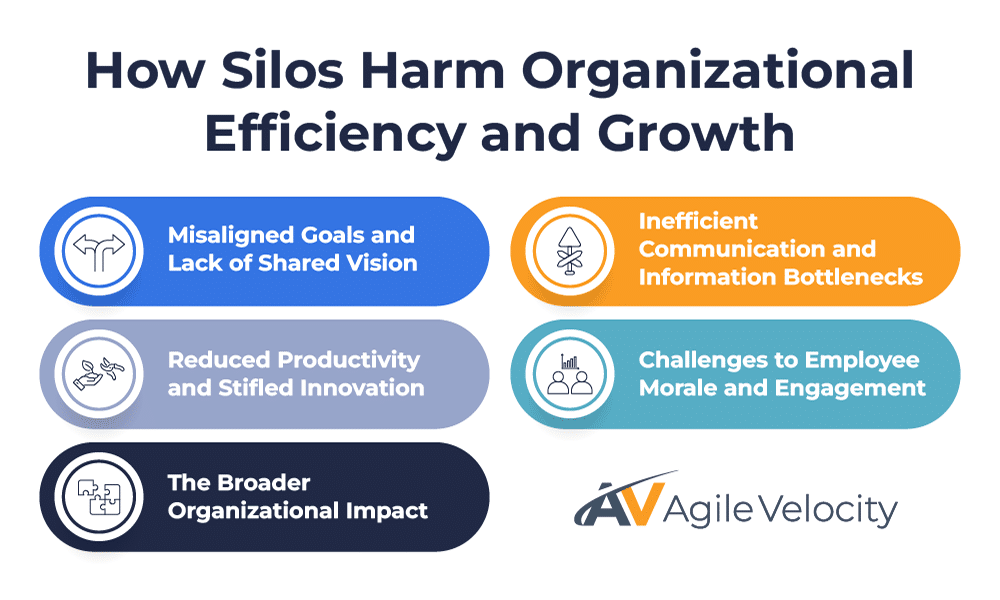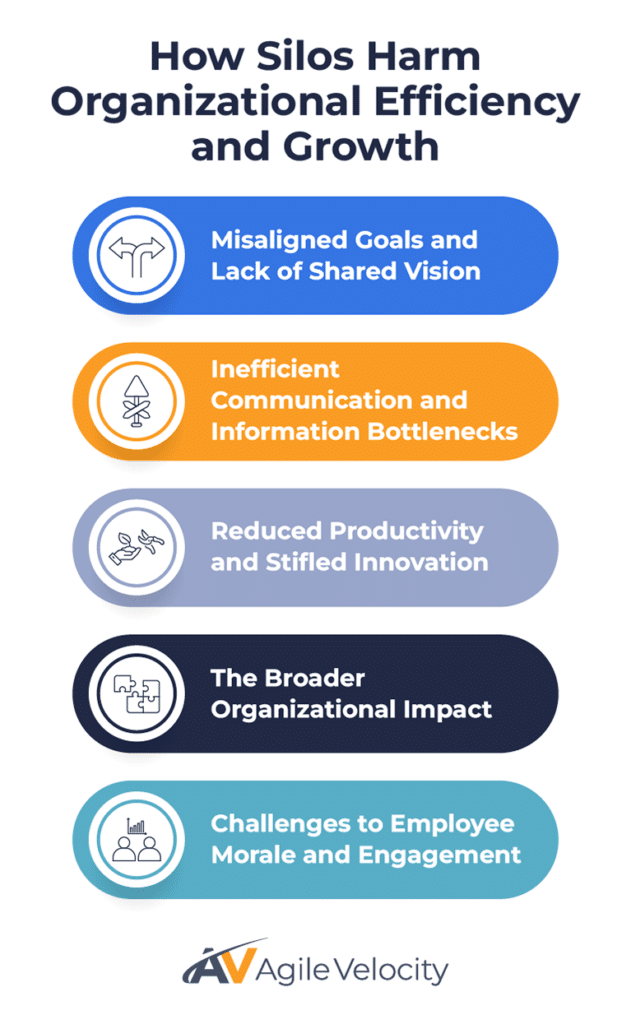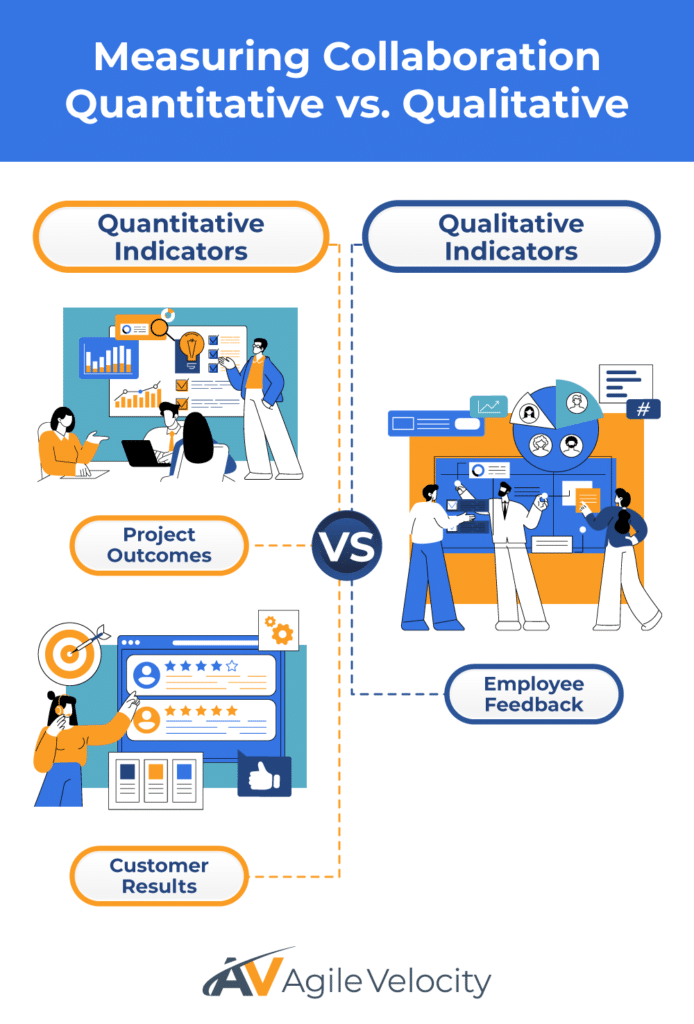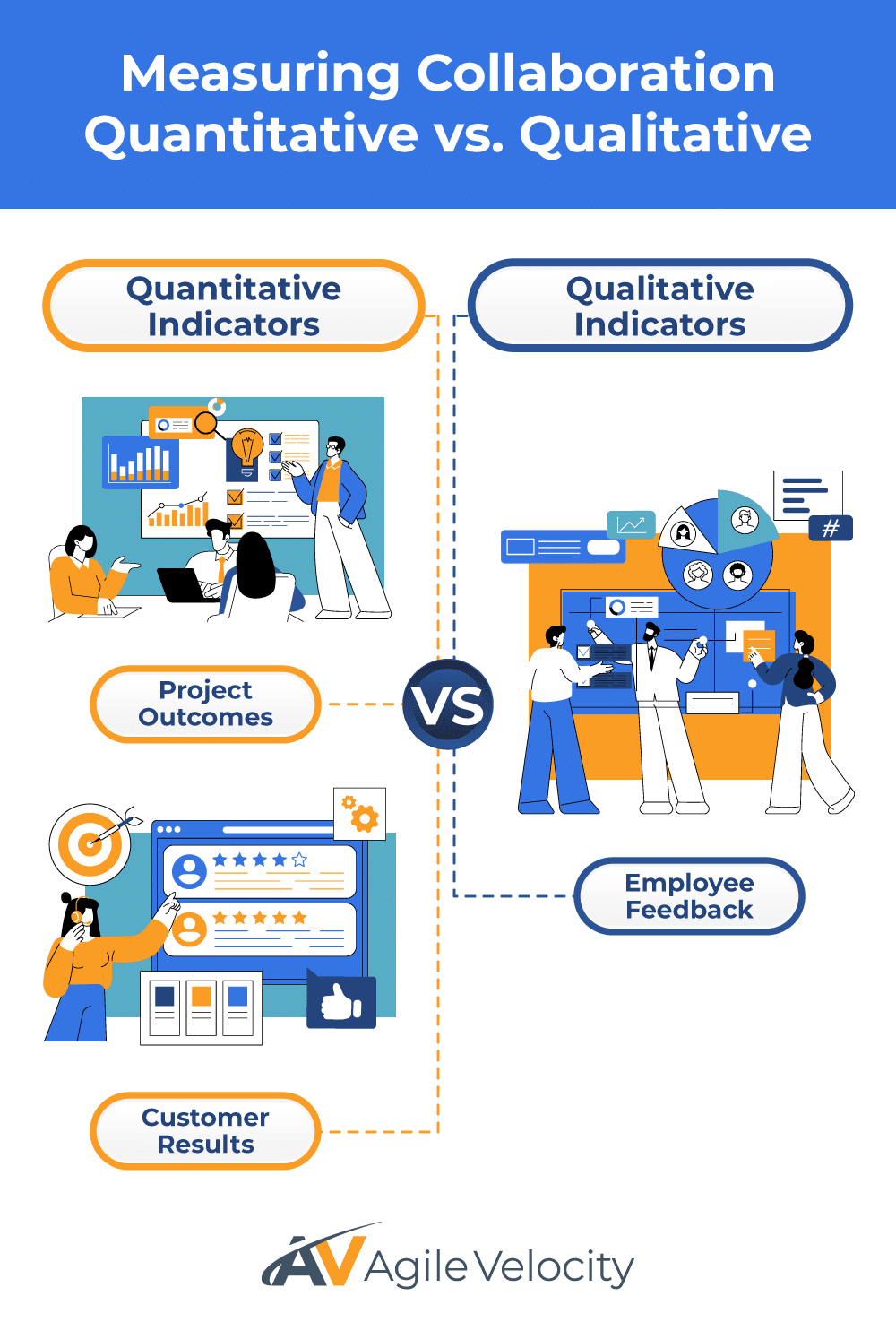Many organizations aim to deliver innovative solutions, exceptional products, and seamless services. However, a significant obstacle often stands in their way: the presence of organizational silos. These silos occur when teams or departments operate in isolation, hindering communication, collaboration, and the efficient pursuit of shared goals. Silos create barriers that can stifle progress, reduce productivity, and limit innovation.
By breaking down these silos, leaders can unlock the power of cross-functional collaboration, foster stronger relationships between teams, and empower their organizations to adapt to change more effectively. This shift not only removes roadblocks, but also opens pathways to greater organizational agility.
In this article, we’ll explore how workplace silos negatively impact organizations and how to break them through Agile Transformation, strategic communication, and effective alignment. Agile Methodologies like Scrum and SAFe® offer practical frameworks to eliminate barriers and foster a culture of shared accountability, and teamwork. Additionally, various tools can help organizations visualize areas for improvement, set priorities, and enable teams to work cohesively.
Through proven strategies and actionable insights, we’ll look at ways to cultivate a more open, transparent, and collaborative work environment. The result? Improved delivery, enhanced innovation, and sustainable growth in teams, and organizations alike.
Understanding Silos and Their Impact on Organizations
Workplace silos can develop for various reasons, including misaligned departmental goals, communication breakdowns, or a company culture that prioritizes hierarchies over teamwork. In technology-driven organizations, the problem is often exacerbated by teams working in isolation, focusing solely on their specific objectives rather than contributing to a shared vision. For instance, a software development team might operate independently from analytics or infrastructure groups, creating a disconnect that limits the organization’s ability to innovate or respond effectively to challenges. Silos also thrive when success metrics are designed for individual departments rather than the organization as a whole.
The effects of these silos can be disruptive. When teams lack formalized lines of communication, knowledge gaps emerge, collaboration stalls, and trust deteriorates. This hinders the organization’s ability to move swiftly, whether it’s developing new features, delivering products, or adjusting to market needs. Without coordination, innovation stagnates, decision-making slows, and employee engagement declines.
To address these challenges, organizations must shift toward principles of openness, shared understanding, and psychological safety. Agile Methodologies such as Scrum, Kanban, SAFe®, Extreme Programming (XP), and Large-Scale Scrum (LeSS), provide proven frameworks to foster collaboration and transparency. These approaches reimagine how work is planned, executed, and reviewed, breaking down silos and cultivating an environment where teamwork and accountability flourish.
By adopting Agile practices, organizations can replace isolated operations with cohesive, cross-functional approaches. Teams become aligned with organizational goals, fostering not only collaboration but also a culture of continuous improvement. This transformation allows businesses to adapt, innovate, and succeed in today’s constantly changing landscape.
The Detrimental Impact of Silos on Team Dynamics
Workplace silos can have far-reaching consequences that impact communication, productivity, and the overall success of an organization. When teams or departments operate in isolation, the lack of alignment and cooperation creates inefficiencies that ripple across workflows, decision-making, and employee morale. Here’s a closer look at how silos negatively affect organizations:
Misaligned Goals and Lack of Shared Vision
Silos often result in teams focusing solely on their own departmental objectives rather than striving for a cohesive organizational vision. Without a unified direction, teams may duplicate efforts, compete for resources, or prioritize tasks in ways that are counterproductive to the broader mission. For example, a marketing team might create a campaign without consulting the product team, inadvertently overpromising features that aren’t yet deliverable. This lack of alignment creates confusion, delays progress, and makes it difficult for leadership to drive strategic initiatives forward.
When an organization lacks a shared vision, decision-making becomes reactive and fragmented. Opportunities to pursue high-impact goals are often missed, and teams may work at cross-purposes, further exacerbating inefficiencies.
Inefficient Communication and Information Bottlenecks
Silos act as communication barriers, creating bottlenecks that prevent the free flow of information between teams. When important updates and insights are not shared across departments, teams operate with incomplete or outdated data, leading to errors and misinformed decisions. For example, a development team might not be aware of last-minute changes from a design team, causing delays or wasted efforts in rework.
These communication breakdowns can disrupt timelines, stall collaboration, and frustrate teams. Over time, a lack of transparency erodes trust, making it harder for employees to collaborate effectively.
Reduced Productivity and Stifled Innovation
Working in silos limits opportunities for collaboration and deprives teams of diverse perspectives that could spark innovative solutions. Instead of sharing ideas and pooling expertise, teams remain focused on their respective tasks, missing the chance to identify creative ways to improve processes or products. This lack of cross-functional collaboration fosters a stagnant environment where groundbreaking ideas struggle to emerge.
Moreover, silos reduce overall organizational productivity. Without a system to coordinate efforts, teams waste valuable time addressing redundancies or fixing errors caused by misaligned priorities. The absence of continuous improvement makes it harder for organizations to keep pace with competitors in fast-evolving markets.
Challenges to Employee Morale and Engagement
When teams are siloed, employees can feel isolated or undervalued. For example, a sales team might struggle to meet customer demands because the production team hasn’t communicated inventory constraints. This disconnect leads to frustration and mounting workloads, which directly impact morale.
High-performing employees are particularly vulnerable in siloed environments. The lack of recognition for cross-department contributions or the inability to influence company-wide outcomes can cause dissatisfaction. Over time, this results in lower engagement, burnout, and higher turnover rates—a costly consequence for any organization, especially one relying on specialized knowledge workers in technology-driven roles.
The Broader Organizational Impact
Silos not only create internal dysfunction but also harm external-facing outcomes, such as product quality and customer satisfaction. Poor collaboration slows the delivery of innovative solutions, while internal misalignment affects the ability to meet customer needs effectively. Ultimately, siloed organizations struggle to adapt to change, leaving them at a competitive disadvantage in rapidly shifting industries.
Addressing these challenges requires a deliberate effort to foster alignment, communication, and collaboration. By breaking down silos and prioritizing cross-functional teamwork, organizations can unlock their full potential to innovate, adapt, and thrive.
The Importance of Breaking Down Silos to Foster Collaboration

In today’s dynamic business environment, cross-functional collaboration is no longer optional—it’s essential for building resilient and responsive organizations. Breaking down silos removes the barriers that prevent teams from working together, enabling them to align around shared goals and pool their collective expertise to solve complex problems. When collaboration thrives, organizations are better equipped to adapt quickly, deliver quality outcomes, and innovate at scale.
The elimination of silos fosters a culture of accountability and transparency. Teams gain a clearer understanding of how their work impacts others, and contributes to broader organizational objectives. This alignment transforms disparate teams into cohesive units, where resources, ideas, and solutions flow seamlessly across departments. It also creates an environment where managers can deploy resources strategically, directing efforts where they’re needed most.
Breaking silos doesn’t just improve operational efficiency—it has far-reaching benefits for the workforce. Employees become more engaged and motivated when they see how their roles fit into the company’s larger mission. Collaborative environments create opportunities for individuals to learn from one another, fostering stronger relationships and deeper camaraderie. Teams that share successes and celebrate milestones collectively build a sense of pride and commitment, enhancing overall morale.
Perhaps most importantly, collaboration is the cornerstone of organizational agility. Agile organizations thrive on their ability to adjust, iterate, and execute in changing environments. When silos are eliminated, teams can respond faster to shifting priorities, market demands, or emerging challenges. Cross-functional collaboration builds a nimble workforce, ready to embrace new ways of working while continuously striving for innovation and improvement.
By prioritizing collaboration and breaking down silos, organizations open the door to accelerated decision-making, higher productivity, and better results. The shift to a connected, transparent way of working empowers businesses to succeed in the face of change while unlocking the full potential of their teams.
Strategies to Break Down Silos in Organizations
Breaking down silos requires deliberate strategies that go beyond surface-level fixes to create lasting change. By embedding transparency, aligning teams, and fostering collaboration, organizations can replace silos with an environment rooted in trust, shared goals, and collective success. The following strategies provide actionable ways to dismantle silos and guide organizations toward improved teamwork, communication, and results.
Build a Culture of Openness and Transparency
A foundational step to eliminating silos is fostering a culture where information flows freely. Transparent environments encourage teams to share updates, insights, and challenges across functions, breaking down walls of isolation. Leaders play a pivotal role by modeling openness—openly sharing project updates, admitting setbacks, or giving visibility into high-level organizational goals.
Agile practices such as Sprint Retrospectives are particularly effective for nurturing this openness. These regular sessions provide structured opportunities for teams to voice concerns, celebrate wins, and address cross-functional challenges in a safe environment. Additionally, frequent feedback loops can keep communication fresh and meaningful, helping teams understand how their work ties into broader objectives.
Managers should also emphasize the value of cross-functional transparency by introducing tools or frameworks that promote collaboration. Visual aids like Kanban Boards can clearly display progress, highlight bottlenecks, and help all departments stay aligned. When transparency becomes a guiding principle, silos naturally begin to dissolve.
Leverage Agile Frameworks to Unite Teams
Agile Methodologies are designed to promote collaboration by breaking work into manageable chunks and emphasizing continuous alignment. By adopting these frameworks, organizations can create systems that naturally foster open communication and teamwork.
- Scrum: This framework drives collaboration through iterative Sprints, where teams set goals, revisit progress, and review outcomes during events like Sprint Planning, the Daily Scrum, and Sprint Retrospectives. Defined roles—such as the Product Owner, Scrum Team, and Scrum Master—create clarity and accountability.
- Kanban: A visual workflow approach that keeps tasks flowing smoothly. With Kanban Boards and Work In Progress (WIP) Limits, teams can identify blocks and improve efficiency as tasks move through the system.
- SAFe®: Ideal for scaling up collaboration across teams in larger organizations, SAFe uses Iterations, Planning Intervals, and tools like the Agile Release Train (ART) to align strategy with execution.
- Large-Scale Scrum (LeSS): This extension of Large-Scale Scrum (LeSS) simplifies managing large projects by applying consistent principles across multiple teams without losing focus on collaboration and feedback.
- Scrum@Scale™: Designed for scaling Agile practices, Scrum@Scale™ emphasizes alignment across cross-functional teams while retaining the agility of smaller Scrum Teams.
- Extreme Programming (XP): Extreme Programming (XP) focuses on short Iterations, continuous integration, and test-driven development to deepen collaboration between developers and stakeholders, ensuring quick feedback and adjustments.
With the help of these and other Agile frameworks, organizations can break down silos, streamline communication, and establish a rhythm where teams frequently realign around shared objectives. Agile coaching can further strengthen these efforts, offering hands-on guidance in applying these methods effectively across the enterprise. An experienced coach can help organizations determine who needs to plan and execute together to maximize the results.
Use Tools for Strategic Clarity
Eliminating silos becomes easier when teams have a clear view of their interdependencies, goals, and priorities. Various tools can help organizations pinpoint where silos exist, visualize how different teams contribute to higher-level objectives, and track progress toward collaborative milestones.
By providing leaders and teams with a roadmap for improving workflows, these tools offer clarity on what needs to change and why. For example, they can uncover overlapping responsibilities that cause friction or highlight inefficiencies in handoffs between groups. Once these pain points are identified, leadership can guide teams toward common solutions to work cohesively and reduce wasted effort.
Ultimately, such tools provide organizations with the visibility needed to align priorities, focus on delivering value, and establish shared accountability. This creates ongoing feedback that ensures teams understand how their roles contribute to broader successes, further strengthening collaboration.
Commit to Continuous Improvement Through Collaborative Reflection
Breaking silos isn’t a one-time activity—it’s an ongoing process. Once barriers between teams are removed, the next challenge is preventing them from re-forming. This is where Agile’s commitment to continuous improvement becomes essential.
Agile frameworks like Scrum and SAFe create regular reflection points through Iterations, where teams assess what went well, what didn’t, and what can be improved. Collaborative events such as Retrospectives allow cross-functional teams to address potential challenges and refine their processes together.
For example, if two teams discover overlapping efforts during a Sprint, they can use the Retrospective to develop a unified approach, like sharing a consolidated backlog or setting clearer task ownership moving forward. These iterative adjustments reinforce open communication and help teams proactively identify and resolve emerging silos before they take hold.
In larger settings, such as a company acquisition, a new strategic initiative, product launch or entry into a new industry, the continuous cycle of inspection and adaptation can help organizations navigate big changes without introducing new silos.
Lead by Example: Leadership’s Role in Breaking Silos
Leaders are the linchpins of any effort to dismantle silos. When executives and managers model collaborative behavior, it sets the tone for the rest of the organization. For instance, leaders can hold cross-departmental reviews to ensure interdependent teams are aware of each other’s contributions and challenges. They can also recognize and celebrate examples of cross-functional teamwork to highlight its importance.
Metrics also play a role in demonstrating commitment to collaboration. When leaders shift performance metrics from siloed departmental achievements to shared goals—such as improving time-to-market or delivering quality features across departments—it signals that collaboration is a priority.
Leaders must also actively listen to feedback across teams, ensuring employees feel heard and valued. This support creates a trusting environment where collaborative behaviors can flourish, further eroding silos.
Final Reflections on These Strategies
Breaking down silos is about creating a culture and systems that promote transparency, alignment, and open communication. By fostering trust, adapting Agile Methodologies, leveraging collaborative tools, and modeling collaborative behavior, organizations can pave the way for stronger cross-functional teamwork.
When silos dissolve, businesses are better positioned to innovate, adapt to change, and achieve their goals. Whether your organization is just beginning its journey or facing challenges along the way, these strategies provide a strong foundation for sustainable collaboration that leads to long-term success.
Practical Steps to Enhance Collaboration in Organizations
Breaking down silos and fostering collaboration requires a purposeful approach, combining clear communication practices, structured frameworks, and organizational alignment. Below are actionable steps organizations can take to enhance teamwork and ensure cross-functional collaboration.
Foster Clear Communication Channels and Practices
Effective communication is the backbone of collaboration. Start by establishing consistent, structured methods to keep all teams informed and aligned. For example, set up concise sessions where teams share their progress and resolve dependencies. These gatherings should focus on solutions, with more detailed discussions saved for smaller breakout groups.
For distributed and remote teams, leverage technology to create open channels of communication without overwhelming employees. A visible board, such as a Kanban Board, can be especially helpful for tracking departmental progress and identifying blockers in real time. Encouraging transparency ensures teams can quickly address challenges while staying aligned with organizational objectives.
Use Lean Portfolio Management (LPM) to Drive Strategic Alignment
Lean Portfolio Management (LPM) helps organizations tie team efforts to larger strategic goals while maintaining flexibility in resource allocation. This approach allows leadership to evaluate workstreams holistically, uncover redundancies, and align tasks with business priorities.
By focusing on regular checkpoints rather than waiting until quarter’s end, leadership can recalibrate resources and priorities as needed. This emphasis on iterative adjustments ensures that every team remains focused on high-value outcomes. Ultimately, a clear connection between strategic goals and day-to-day tasks eliminates confusion, reduces inefficiencies, and reinforces cross-organizational collaboration.
Encourage Cross-Functional Workshops and Team Connection Events
Workshops and team-building events provide opportunities to break silos and increase collaboration. By bringing together individuals from different departments, organizations can create spaces for brainstorming, problem-solving, and relationship-building. Cross-functional workshops spark creativity by combining diverse perspectives, generating ideas that would be less likely to emerge within a single team.
The return to office environments offers a chance to rebuild interpersonal bonds that may have weakened during remote work. Hosting in-office workshops or virtual alternatives (for hybrid teams) enables departments to collaborate more effectively. Structured activities with clear goals—such as mapping dependencies—help solidify alignment and encourage empathy across departments.
Commit to Agile Coaching and Training for Teams and Leaders
Adopting Agile Methodologies often requires a cultural and behavioral shift, which is why coaching and training are essential. Leaders benefit from training that focuses on eliminating siloed metrics, managing cross-team dependencies, and fostering transparency. Empowering leadership to champion collaboration sets the tone for the organization.
Teams also benefit from hands-on Agile training workshops where they learn the fundamentals of frameworks like Scrum or SAFe. These sessions explain key concepts, such as Sprint Planning, the Daily Scrum, and managing a Product Backlog. Through such training, employees embrace a mindset of shared ownership, collaboration, and continuous improvement, ensuring they see their work as part of the bigger picture.
Drive Collaboration Through Structured Feedback and Reflection
Improving collaboration isn’t a one-time effort—it requires an ongoing commitment to continuous improvement. Agile Retrospectives and similar reflection sessions allow teams to analyze workflows, relationships, and outcomes. These events encourage teams to identify areas for improvement, share lessons learned, and refine processes together.
For instance, if overlapping responsibilities arise, Retrospectives can help teams decide how to streamline handoffs or clarify task ownership. This iterative approach prevents silos from resurfacing and keeps collaboration effective over time. Encouraging teams to reflect on challenges and celebrate wins strengthens their bond and reinforces a culture of accountability and shared success.
How Organizational Agility Supports Sustainable Collaboration

organizational agility is the ability of an organization to adapt, respond, and thrive in changing conditions. It goes beyond rigid hierarchies or top-down decision-making by emphasizing speed, alignment, and inclusivity across all levels of the business. By adopting Agile Transformation and instilling collaboration as a core value, organizations can create systems that support sustainable teamwork and seamless communication.
With organizational agility, decision-making becomes more decentralized, empowering cross-functional teams to make informed choices based on real-time data, customer feedback, and Agile frameworks. This approach eliminates delays caused by hierarchy-driven sign-offs. It also fosters a more transparent and feedback-driven culture, where collaboration is based on shared goals rather than competing departmental agendas.
Lean practices further enhance this adaptability by removing inefficiencies, reducing wasteful activities, and enabling teams to focus on tasks that drive meaningful outcomes. Organizations practicing Lean and Agile principles can respond to shifting priorities or market needs more effectively while maintaining alignment across all teams. This adaptability allows teams to work cohesively and meet changing demands with creativity and speed.
Agile Velocity specializes in guiding companies to embed these principles into their culture and operations. Rather than merely deploying new processes, Agile Velocity helps weave Agile frameworks into the fabric of daily practices. By blending organizational coaching, structured alignment, and behavior reinforcement, they facilitate a long-term embrace of collaboration rather than a short-term fix.
The result? Teams become self-sufficient collaboration champions, improving both operational success and employee satisfaction. Sustainable collaboration, supported by organizational agility, gives organizations the tools they need to continuously innovate and deliver value in ever-changing environments.
Addressing Common Challenges When Breaking Down Silos
Breaking down silos is not an overnight process. Organizations often face obstacles when attempting to foster cross-functional collaboration, and addressing these challenges requires thoughtful strategies. Below are some common hurdles and ways to overcome them.
Managing Resistance to Change
Resistance to change is one of the most common barriers organizations face when dismantling silos. Employees and leaders may fear losing control or visibility when moving toward a collaborative approach. These concerns stem from uncertainty about how cross-functional goals will impact individual performance or departmental priorities.
To ease this resistance, leaders should prioritize transparency. Show how collaboration benefits not just the organization, but also individuals—highlighting career development opportunities, improved productivity, and broad recognition for impactful work. Regular feedback sessions can also help address concerns and demonstrate that team members’ voices are valued.
Additionally, celebrate early wins to reinforce positive outcomes. Recognize a team that successfully worked across departments or solved a shared challenge. Offering visible examples of success helps build confidence and shows that collaboration leads to better outcomes.
Aligning Teams with Organizational Goals
Another key challenge is ensuring that cross-functional teams stay aligned with broader organizational objectives. When departments focus solely on their individual priorities, it’s easy to lose sight of shared goals, resulting in resource conflicts or misaligned outputs.
Leaders can address this by providing clear, accessible documentation of organizational priorities—like strategic visions or high-level roadmaps. Ongoing communication ensures that everyone understands where their roles fit into the bigger picture. Combining these efforts with Lean Portfolio Management keeps teams aligned on delivering the highest-value outcomes.
Measuring Collaboration Success
Once collaboration initiatives are underway, measuring their success is essential to sustain long-term buy-in and improvement. Without clear metrics, teams might struggle to see the value of breaking down silos.
Organizations can track collaboration using both qualitative and quantitative indicators. For example:
- Project outcomes: Reduced cycle time, on-time delivery rates, or improved product quality.
- Employee feedback: eNPS scores, retrospectives and other sessions reveal how cross-team work impacts morale and productivity.
- Customer results: Greater satisfaction and faster responses to market shifts.
Leaders should also look for evidence of reduced rework and smoother workflows, as these signal improvements in communication and alignment. Sharing these results with all departments reinforces the tangible benefits of collaboration and encourages further progress.
Unlocking Organizational Success: The Path Forward
Workplace silos can act as hidden barriers, slowing innovation, diminishing team morale, and stifling progress. Truly breaking these silos requires a cultural shift toward transparency, alignment, and shared accountability. By fostering open communication, prioritizing cross-functional collaboration, and embedding Agile frameworks like Scrum or SAFe into daily operations, organizations can pave the way for sustainable and impactful teamwork. Tools designed to visualize areas for improvement and consolidate priorities also provide the clarity needed to streamline workflows and keep teams moving toward common objectives.
To solidify these efforts, it helps to have a proven roadmap for Agile Transformation. That’s where the Path to Agility approach and Path to Agility® Navigator software comes in. Path to Agility Navigator helps organizations see exactly what needs to change, track progress along the way, and define next steps to make Agile stick. By using Path to Agility Navigator to spotlight cross-departmental goals, teams can collaborate more effectively and truly reap the benefits of Agile.
Ready to transform your organization? Reach out to Agile Velocity to learn how Agile practices, along with Path to Agility Navigator, can empower your teams, enhance collaboration, and unlock your organization’s full potential. Together, we can create the foundation for lasting success.







